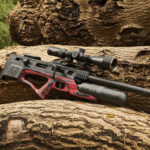It’s always exciting when any branch of the US military starts flirting with a new cartridge, and it’s hard to think of a recent cartridge that has generated more excitement than the SIG .277 Fury.
On paper, this round has some truly staggering statistics, and there are rumblings that the Army is eyeing it to at least partially replace the much-beloved 5.56 NATO.
Today, we’re going to take a look at this new round, the guns that go with it, and what it means for us average Joes and Janes in the civilian world.
Table of Contents
WHERE .277 FURY CAME FROM
In April 2022, the US Army announced that they’d selected SIG Sauer’s XM5 rifle and .277 Fury ammunition to partially replace the M4.
So does that mean the M4 and 5.56 are on the way out?
Not even close.
For one, the .277 Fury and the XM5 are only partial replacements.
For two, the Army has hemmed and hawed about replacing the M16/M4 off and on for the almost six decades, and nothing comprehensive has happened yet. The M16/M4 is just too hard to beat in terms of versatility, reliability, and affordability.
While the adoption announcement came in 2022, our story actually begins back in 2017, when the US Army launched the Next Generation Squad Weapon Program (NGSW) to find a common system of 6.8mm cartridges, along with arms to go with them, to replace the 5.56mm M4 carbine, the M249 SAW light machine gun, and the 7.62mm M240 machine gun.
The Army invited firearms manufacturers to submit a new cartridge and accompanying rifle system that met a few different requirements.

The rifle could be no bigger than 35 inches long and 12 pounds (with attachments), able to accurately hit targets out to 610m, able to suppress targets out to 1200m, and able to use small arms fire-control systems.
The ammo needed to match that accuracy, pierce near-peer body armor out to 500m, and use a 6.8mm projectile.
.227 Fury was SIG Sauer’s design for the program, hoping to be adopted. Clearly, that worked out. The round was accepted by SAAMI in 2020, then the round, along with the accompanying XM5 and XM250 LMG rifles, was adopted by the US Army in 2022.
But let’s talk about what the round can do.
.277 FURY CONSTRUCTION & BALLISTICS
When looking at .277 Fury’s ballistics, it’s likely that one of the first things you’ll notice is the round’s incredibly high chamber pressure, 80,000 PSI.
In contrast, the chamber pressure of 5.56 NATO is only roughly 75% of that, at about 60,000 PSI, while 6.5 Creedmoor and .308 Win have only slightly higher chamber pressures at 62,000 PSI. Even a .338 Lapua Magnum is only about 60,000 PSI. In fact, SAAMI recommends that cartridges don’t exceed 65,000 PSI.
So to accommodate for this much higher-than-usual chamber pressure, SIG had to make some unusual design choices.
At first glance, the case seems pretty normal. The body is brass, and while it’s thicker than you’d typically see, it’s not too unusual. Where things really get shaken up is the base of the case, which is made from a separate stainless steel piece, allowing the case to tolerate the higher pressure. The pieces connect with a locking washer.

But what does that higher pressure mean for the performance of this round?
Well, .277 Fury sends a 140 gr round down range at 2,950 ft/s (900 m/s). For comparison, a similarly sized 6.5 Creedmoor round will achieve only about 2,710 ft/s (830 m/s).

That allows the Fury to maintain accuracy at significantly further distances than even Creedmoor, which was specifically designed for long-range target shooting. .277 Fury has a -41 inch drop at 500 yards, compared to 6.5 Creedmoor’s -53 inch drop.
At 1000 yards, SIG says the .277 Fury will drop a whole six feet less than 6.5 Creedmoor and hit the target with 25% more energy.
The real kicker? To reach that speed at the muzzle, Creedmoor needs about a 24-inch barrel, while the Fury will come out of a barrel that’s 8 inches shorter.
If you send a 6.5 Creedmoor out of a 16” barrel you’re looking at more like 2,450 FPS Vs. .227 Fury’s 2,950.
We see higher velocity, around 3,100 f/s, from 5.56 NATO, but with a much smaller projectile, around 62 gr, and the 5.56 NATO doesn’t maintain its trajectory nearly as well either, with a drop of about -90 inches at 500 yards.

All in all, the .277 Fury sounds a whole heck of a lot more effective than 5.56, and looks to be a marked improvement over even something like 6.5 CM…but I still don’t see 5.56 getting replaced anytime soon.
Downsides?
While all that performance sounds great, it’s key to remember that a lot of it comes from the fact that the bullets are about 3 times as heavy as 5.56 NATO. From a boots-on-the-ground perspective, that weight is a lot. We’re already sending our armed forces into harm’s way, carrying a lot of weight. Equipping them with .277 FURY either means a lot more weight or a lot less ammo on their person.
This demands the question, can this really be a viable 5.56 replacement for the average infantry? The Army seems to think so. For now.
Also, the idea of defeating body armor at 500 yards is a big part of the development here, which is a need our military hasn’t really had in most recent conflicts. It’s clear with this requirement that the Army is looking ahead to modern battlefields against better-equipped opponents than what we’ve seen in the last several decades.
Then again, based on what the world has seen in Ukraine for the last year, past reports of “near-peer body armor” might be overstated.
All in all, the .277 Fury is a pretty incredible round, especially for long ranges, but it’s more of a specialty round, while the 5.56 NATO is more of a generalist. Of course, for what .277 Fury is for, it’s very, very good.
The bottom line is that .277 Fury is something of a monster. 6.5 Creedmoor is nothing to sneeze at, and .277 Fury makes 6.5 Creedmoor looks like its kid brother.
WHAT DOES ALL THIS MEAN FOR NORMAL PEOPLE?
Honestly, not much…for now.
The .277 Fury hasn’t had a huge impact in the military as of yet, and it’s certainly not going to replace the AR-15 platform for civilians. And even if you do want to replace your AR with a .277 Fury rifle, there aren’t a lot of options available.
From the time the round was first introduced for civilian use at the end of 2019, Sig had the bolt-action CROSS available for it. At around $1,600 to $1,800, it’s not outrageously priced.
If you can get your hands on it, that is, and that’s a big “if.” While researching for this article, I couldn’t find one in stock anywhere.
Then early last year, SIG introduced the MCX-Spear (SIG’s civilian version of the XM5) chambered in .277 Fury, and just this week added the .308 Win and 6.5 Creedmoor versions. All 3 have an MSRP north of $4,000.
Ammo is a bit easier to get your hands on, but it’s still pretty pricey, generally running at least $1.65 per round for the cheapest stuff. And, of course, you have to get your hands on the rifle first.
On the other hand, other similar rounds like .308 Win and 6.5 Creedmoor are much cheaper and easier to find, and the difference in ballistic performance just isn’t enough to tempt me to pay the higher price for .277 Fury.
So if you’re in the niche group of hunters pushing the 600 to 800-yard range, you might find it worth it, but personally, I’m going to hold off for a while until the price comes down (if it ever does).
Of course, we’ve seen explosions of popularity in rounds adopted by the military, and what the US Army uses has a huge effect on what other service branches pick up. If we start seeing the USMC, Navy, and Air Force picking up .277 rifles, that’s a whole different ball game.
If 6.8×51 becomes a standard NATO cartridge? Forget about. It’ll be around for a hundred years. Will that happen? SIG certainly hopes so, I’m sure, but right now, the Army has only bought into the tune of about $20 million.
Which, in terms of military acquisitions and spending, is basically the equivalent of tipping your Uber Eats driver with a stick of gum.
Still, the round definitely has potential, and it’s one of the most interesting developments in cartridge design that we’ve seen in quite a while, from the hybrid-material case to the insane 80,000 PSI case pressure that blows almost everything else out of the water.
LOOSE ROUNDS
The SIG .277 is a marvel of cartridge development and firearms engineering, but that doesn’t mean it’s a home run just yet. On paper, things look great for this round to succeed and maybe replace some issued M4s.
There are some logistical hurdles in the way of that goal, but it’s always interesting to see a major manufacturer like SIG SAUER really pushing the envelope in terms of cartridge design and putting out something completely new that we haven’t seen before.











































